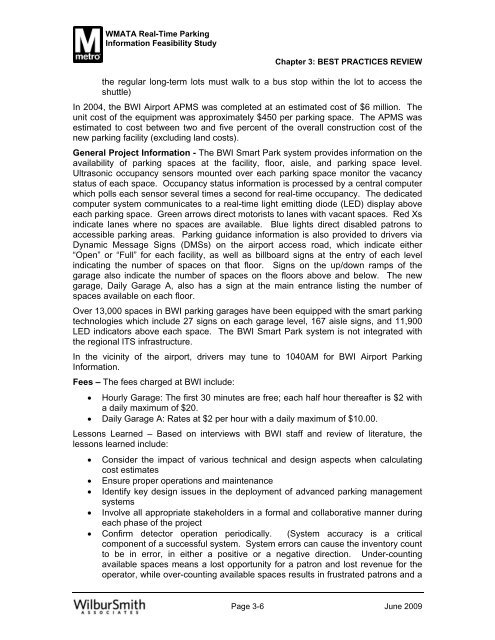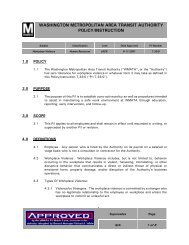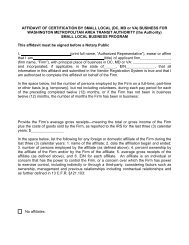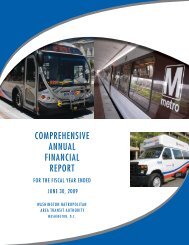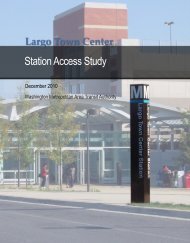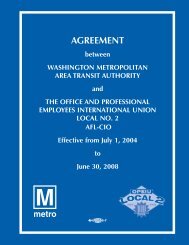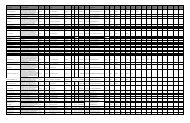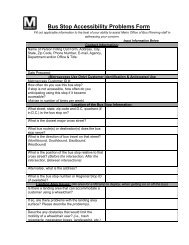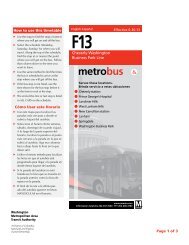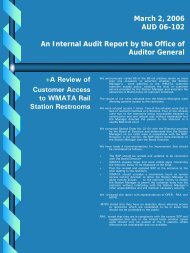feasibility study of real time parking information at ... - WMATA.com
feasibility study of real time parking information at ... - WMATA.com
feasibility study of real time parking information at ... - WMATA.com
Create successful ePaper yourself
Turn your PDF publications into a flip-book with our unique Google optimized e-Paper software.
<strong>WMATA</strong> Real-Time Parking<br />
Inform<strong>at</strong>ion Feasibility Study<br />
Chapter 3: BEST PRACTICES REVIEW<br />
the regular long-term lots must walk to a bus stop within the lot to access the<br />
shuttle)<br />
In 2004, the BWI Airport APMS was <strong>com</strong>pleted <strong>at</strong> an estim<strong>at</strong>ed cost <strong>of</strong> $6 million. The<br />
unit cost <strong>of</strong> the equipment was approxim<strong>at</strong>ely $450 per <strong>parking</strong> space. The APMS was<br />
estim<strong>at</strong>ed to cost between two and five percent <strong>of</strong> the overall construction cost <strong>of</strong> the<br />
new <strong>parking</strong> facility (excluding land costs).<br />
General Project Inform<strong>at</strong>ion - The BWI Smart Park system provides <strong>inform<strong>at</strong>ion</strong> on the<br />
availability <strong>of</strong> <strong>parking</strong> spaces <strong>at</strong> the facility, floor, aisle, and <strong>parking</strong> space level.<br />
Ultrasonic occupancy sensors mounted over each <strong>parking</strong> space monitor the vacancy<br />
st<strong>at</strong>us <strong>of</strong> each space. Occupancy st<strong>at</strong>us <strong>inform<strong>at</strong>ion</strong> is processed by a central <strong>com</strong>puter<br />
which polls each sensor several <strong>time</strong>s a second for <strong>real</strong>-<strong>time</strong> occupancy. The dedic<strong>at</strong>ed<br />
<strong>com</strong>puter system <strong>com</strong>munic<strong>at</strong>es to a <strong>real</strong>-<strong>time</strong> light emitting diode (LED) display above<br />
each <strong>parking</strong> space. Green arrows direct motorists to lanes with vacant spaces. Red Xs<br />
indic<strong>at</strong>e lanes where no spaces are available. Blue lights direct disabled p<strong>at</strong>rons to<br />
accessible <strong>parking</strong> areas. Parking guidance <strong>inform<strong>at</strong>ion</strong> is also provided to drivers via<br />
Dynamic Message Signs (DMSs) on the airport access road, which indic<strong>at</strong>e either<br />
“Open” or “Full” for each facility, as well as billboard signs <strong>at</strong> the entry <strong>of</strong> each level<br />
indic<strong>at</strong>ing the number <strong>of</strong> spaces on th<strong>at</strong> floor. Signs on the up/down ramps <strong>of</strong> the<br />
garage also indic<strong>at</strong>e the number <strong>of</strong> spaces on the floors above and below. The new<br />
garage, Daily Garage A, also has a sign <strong>at</strong> the main entrance listing the number <strong>of</strong><br />
spaces available on each floor.<br />
Over 13,000 spaces in BWI <strong>parking</strong> garages have been equipped with the smart <strong>parking</strong><br />
technologies which include 27 signs on each garage level, 167 aisle signs, and 11,900<br />
LED indic<strong>at</strong>ors above each space. The BWI Smart Park system is not integr<strong>at</strong>ed with<br />
the regional ITS infrastructure.<br />
In the vicinity <strong>of</strong> the airport, drivers may tune to 1040AM for BWI Airport Parking<br />
Inform<strong>at</strong>ion.<br />
Fees – The fees charged <strong>at</strong> BWI include:<br />
• Hourly Garage: The first 30 minutes are free; each half hour thereafter is $2 with<br />
a daily maximum <strong>of</strong> $20.<br />
• Daily Garage A: R<strong>at</strong>es <strong>at</strong> $2 per hour with a daily maximum <strong>of</strong> $10.00.<br />
Lessons Learned – Based on interviews with BWI staff and review <strong>of</strong> liter<strong>at</strong>ure, the<br />
lessons learned include:<br />
• Consider the impact <strong>of</strong> various technical and design aspects when calcul<strong>at</strong>ing<br />
cost estim<strong>at</strong>es<br />
• Ensure proper oper<strong>at</strong>ions and maintenance<br />
• Identify key design issues in the deployment <strong>of</strong> advanced <strong>parking</strong> management<br />
systems<br />
• Involve all appropri<strong>at</strong>e stakeholders in a formal and collabor<strong>at</strong>ive manner during<br />
each phase <strong>of</strong> the project<br />
• Confirm detector oper<strong>at</strong>ion periodically. (System accuracy is a critical<br />
<strong>com</strong>ponent <strong>of</strong> a successful system. System errors can cause the inventory count<br />
to be in error, in either a positive or a neg<strong>at</strong>ive direction. Under-counting<br />
available spaces means a lost opportunity for a p<strong>at</strong>ron and lost revenue for the<br />
oper<strong>at</strong>or, while over-counting available spaces results in frustr<strong>at</strong>ed p<strong>at</strong>rons and a<br />
Page 3-6 June 2009


